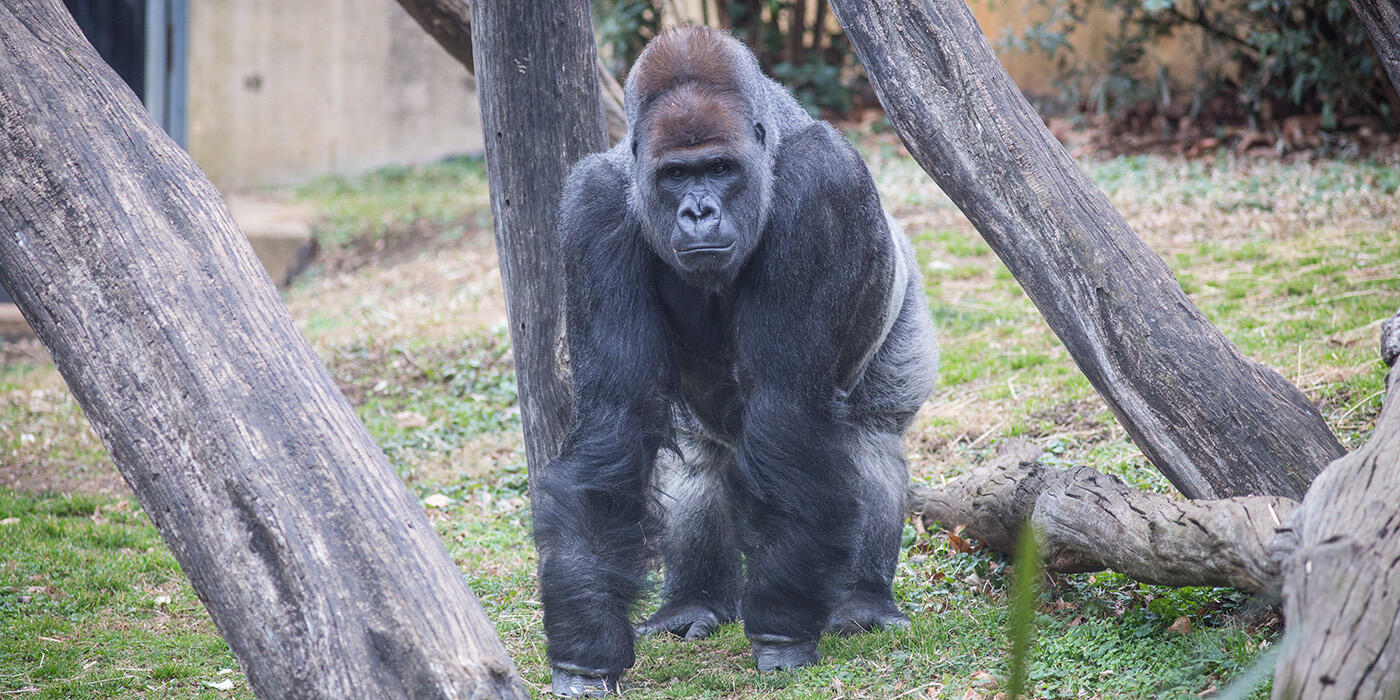#GorillaStory: Moke Makes Moves

This update was written by primate keeper Melba Brown.
Thank you to everyone who extended well-wishes to Moke! Watching him move about the Great Ape House habitat, one would hardly realize he has a fractured femur—he is in great spirits. Our 9-month-old daredevil is standing and walking stronger with each passing day. The healing abilities of gorillas are truly remarkable.
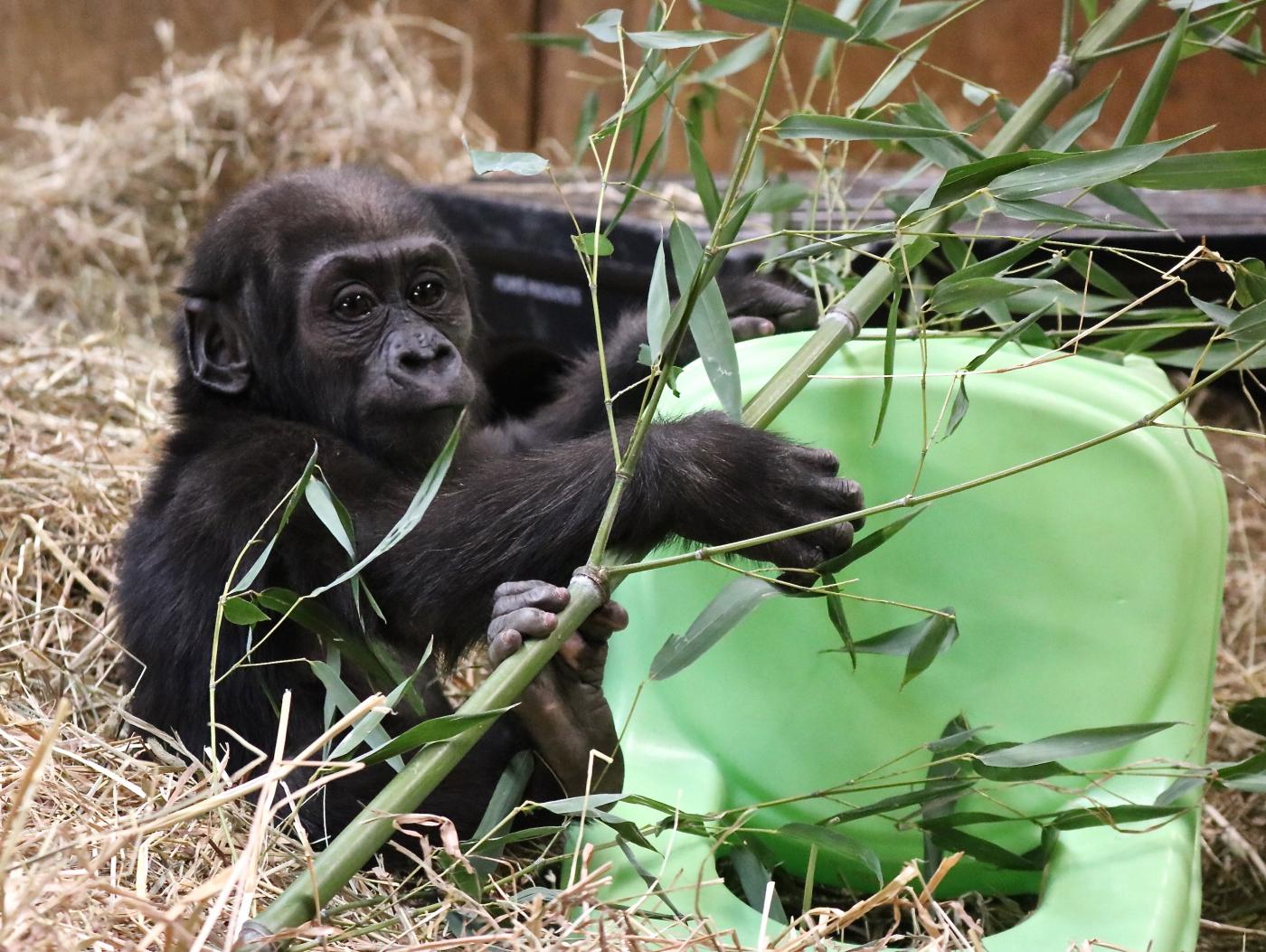
Moke’s mother, Calaya, is most attentive to him, and the primate team has observed her gently inspecting him. His father, Baraka, seems to enjoy Calaya and Moke’s company, though it is clear that he is interested in getting the entire troop together again. Baraka and Calaya frequently sit next to the “howdy” door—a mesh door between two exhibits—so they can be as close to Kibibi and Mandara as possible during Moke’s recuperative time.
They pass hay and food to each other, and Moke will climb the mesh as Kibibi presses her fingers through to make contact. As our curator, Meredith Bastian, mentioned in last week’s Q&A, we have increased the amount of hay bedding in Moke’s enclosure, especially in areas where he likes to climb. That way, if he takes a tumble, he has lots of cushioning beneath him.
In the meantime, Kojo is keeping close surveillance on the situation and weighs in frequently with displays and vocalizations. The primate team is keeping everyone busy with enrichment while Moke takes a much-needed rest. So, far, his recovery is going quite well.
Due to the federal government shutdown last month, we were not able to bring you our regularly scheduled #GorillaStory updates. Let’s take a look back at Great Ape House happenings in January!
Jan. 4
Happy New Year from the primate team to you and yours! Now that winter is upon us and the weather is cooler, our gorillas and orangutans spend the majority of their time indoors. This is because their hair is much like ours: it protects them from the elements, the sun’s rays and biting insects, but it lacks a fluffy undercoat. On cold and blustery days, you will find the apes warm and cozy inside the Great Ape House or Think Tank. Under these circumstances, keepers get extra creative in coming up with enrichment activities that encourage the apes to get some physical and mental exercise.
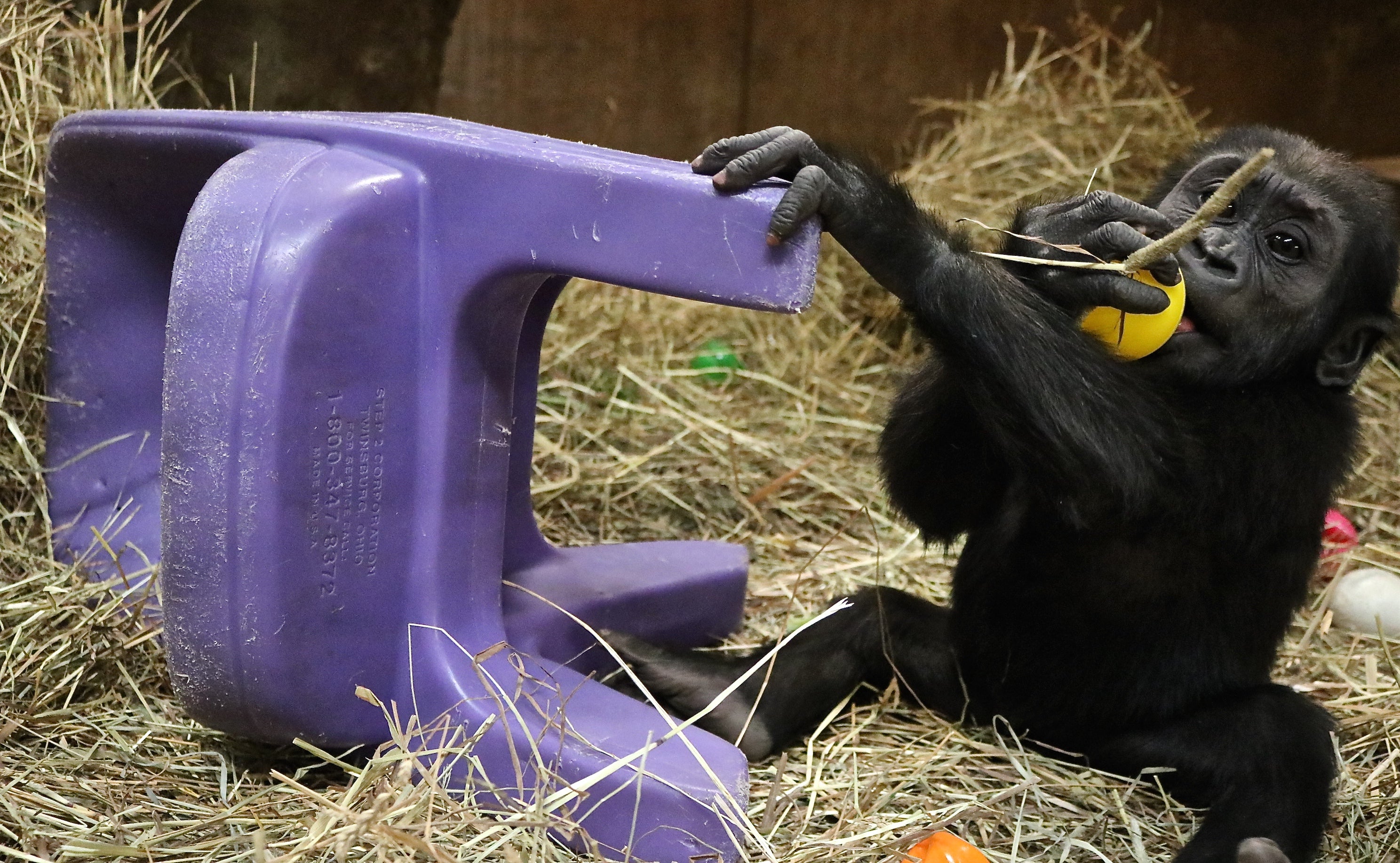

The gorilla side of the Great Ape House was brimming with activity Christmas Day, and the primate team had a great time providing the apes with holiday-themed enrichment. All of the gorillas enjoyed their tree limbs draped with colorful wrapping paper. Moke got a big kick out of the crunch of the paper as he pulled it down, rolled around in it and tore it apart. Kojo received a large, decked-out box and had a great time unwrapping it and discovering the goodies inside. Holiday treats included coconut, popcorn balls, sunflower seeds, bamboo and alfalfa. There was lots of foraging and playing by all!
Over the past few weeks, we have noticed that Baraka spends a greater amount of time with Moke and seems to enjoy moving his son around. He will pick him up by the arm and hoist him in the air, or gently pull Moke by the leg and deposit him a short distance away. Moke still looks at Baraka with reverence, but he is clearly much more comfortable making frequent physical contact with his dad.
On a recent morning, Kibibi, Calaya and Moke were wrestling, and I saw a glimpse of the unstoppable duo that Moke and Calaya will become when he is older. He is sprouting two tiny lower canine teeth and does not hesitate to open his mouth and bare his teeth when he is in the throes of a display! During one particular play session, Calaya and Moke were in the chute that provides passage between the gorillas’ indoor and outdoor enclosures. Moke saw me passing by below and let me know he wanted to play by crouching down and extending his arm towards me. I simply had to oblige! Every time I tickled him, he jumped back and ran to the metal door that leads to the yard and banged it with his fist. This behavior is reminiscent of Baraka’s display when he is in the chute and our other silverback, Kojo, is in the yard. Baraka quickly runs to the door and body slams it or hits it with his fist. Like father, like son! Moke’s displays are more frequent now. He even puts on the characteristic “mean mug” to show just what a tough guy he really is.
One day, a keeper observed Kibibi pick up Moke and carry him over to where her brother, Kojo, was sitting in an adjacent enclosure. Between them was a mesh “howdy” door that provides visual, auditory and tactile contact. Kibibi placed Moke in front of the door, and he and Kojo began interacting through the mesh. Kojo leaned in, and Moke stood face-to-face with him. This scene highlights the solid relationship between Kibibi and Kojo, as she wanted to share her new buddy with him. It is nice to know that Moke is seeing Kojo as an approachable silverback—another role model for him, indeed.
We are all certain that Moke will be a handful when he gets bigger. He is still an infant but growing steadily. At his last weigh-in, he was 14 pounds. I have seen Moke stand on two legs with an erect posture and sure-footed. Time will tell if he expands the amount of time he stands on two legs and actually starts walking, like a few gorillas have been known to do from time to time.
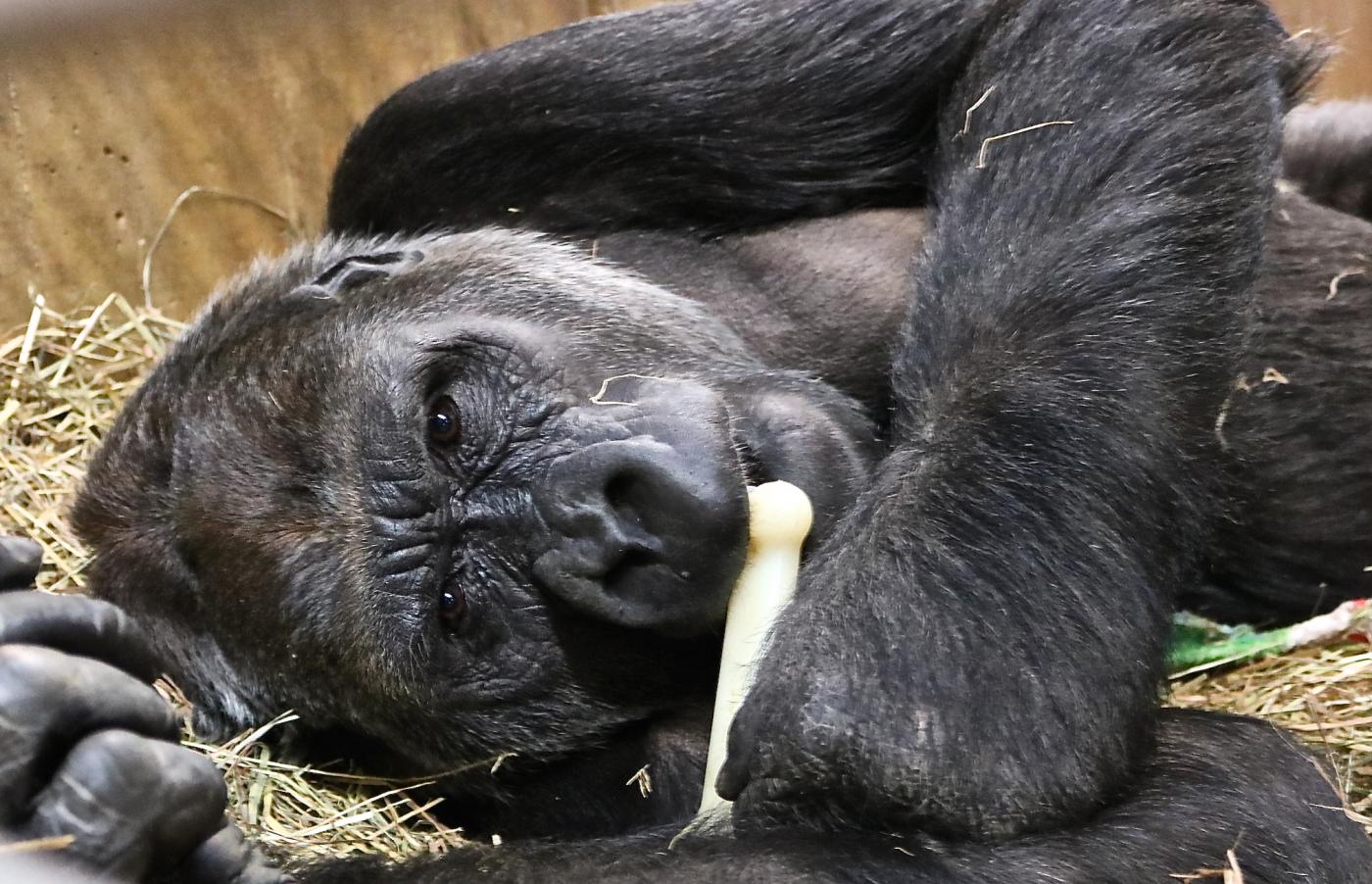
Moke continues to show his strength by climbing here, there and everywhere with ease. He is full of energy and shows initiative. Calaya enjoys Moke’s ever-increasing freedom to roam, but she expends much energy keeping him within reach when he wants to wander and explore. She takes advantage of his time away from her to catch a short nap. Often, when the adults are asleep, he continues to move about and engage with his surroundings. It is interesting to observe him processing the new sights and sounds. He still seeks out Calaya if something frightens him, but this uncertain state tends to dissipate quickly.
We received a question about Moke receiving his flu shot, inquiring as to whether all of the apes receive them. The answer is yes. The adults’ flu vaccines are administered in the arm, just like us. Part of their husbandry training is voluntary arm presentations for injections. As part of our positive reinforcement training program, they receive a big reward for participating: honey! Of all the gorillas, Baraka seems to enjoy receiving his shots the most and is a champ at the process. Moke is not far behind his dad and recently, he voluntarily received his rabies and TDAP vaccines. His actions were met with much praise and grape halves as a hearty reward!
On one occasion, Mandara was resting in the chute and Moke climbed up and approached her. I thought she would move away, as she did before, but she stayed and sat next to him for a while until he left. Such moments indicate the social temperature within the troop. I was glad to see that Mandara was comfortable enough not to retreat.
Something spectacular happened with Mandara that will give you a crystal clear indication of the awareness and brilliance of apes. We had placed a plastic, circular mirror in one of the indoor enclosures for enrichment. At some point in the evening, large pieces of the plastic mirror became dislodged, possibly the result of gorilla manipulation. Mandara was holding a chunk of the plastic mirror and was sitting about 30 feet away from me, up on a high shelf.
I asked the keeper aide who was assisting me that day to go and cut up a banana and bring it to me. I told him that I will see if Mandara will come down to me and trade the wedge for some banana. Mandara was within earshot of our conversation but was clearly engaged with her shiny object. Several minutes later, our volunteer came back with the banana in a cup and placed it on a ledge several feet away from the enclosure.
As I was descending the steps to try to summon Mandara for the trade, she tossed the piece out of the enclosure. I had not even reached the banana cup, nor had I had the chance to ask her for the piece. She had heard what I said, processed it and deposited the mirror directly in front of me! I heaped a mountain of praise on Mandara and rewarded her with a chunk of banana.
At this point, I had an opportunity to ask her if there was any more ‘way over there.’ Mandara turned with unmistakable intention, climbed the tree, went to the shelf, promptly retrieved the last piece and made her way over to me swiftly for the trade. Proudly and with copious pleasure rumbles (a vocalization gorillas make when they are content), she enjoyed the rest of her banana.
We look forward to providing you with updates on Moke, his beautiful family and the rest of our wonderful primates in the new year!
Jan. 18
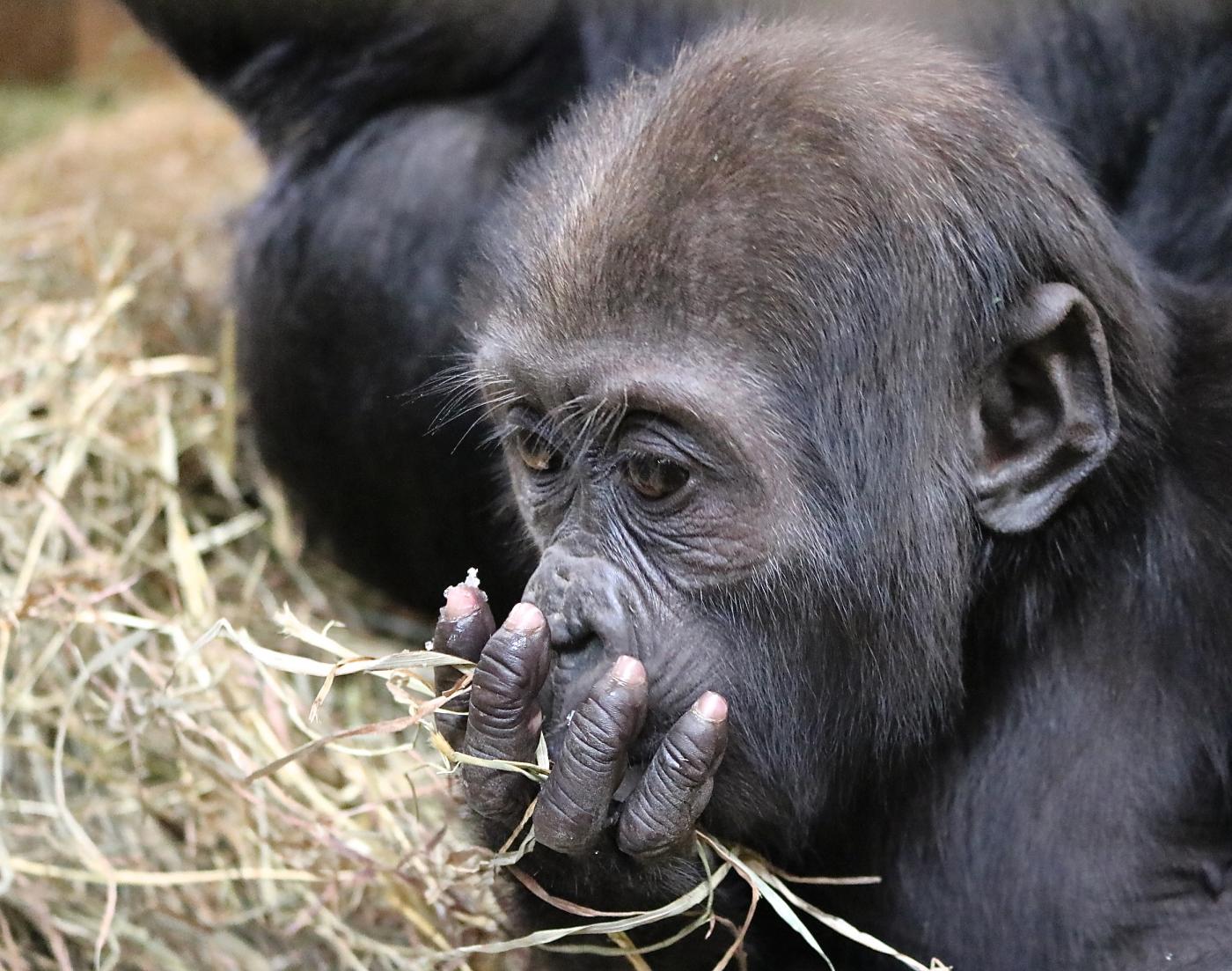
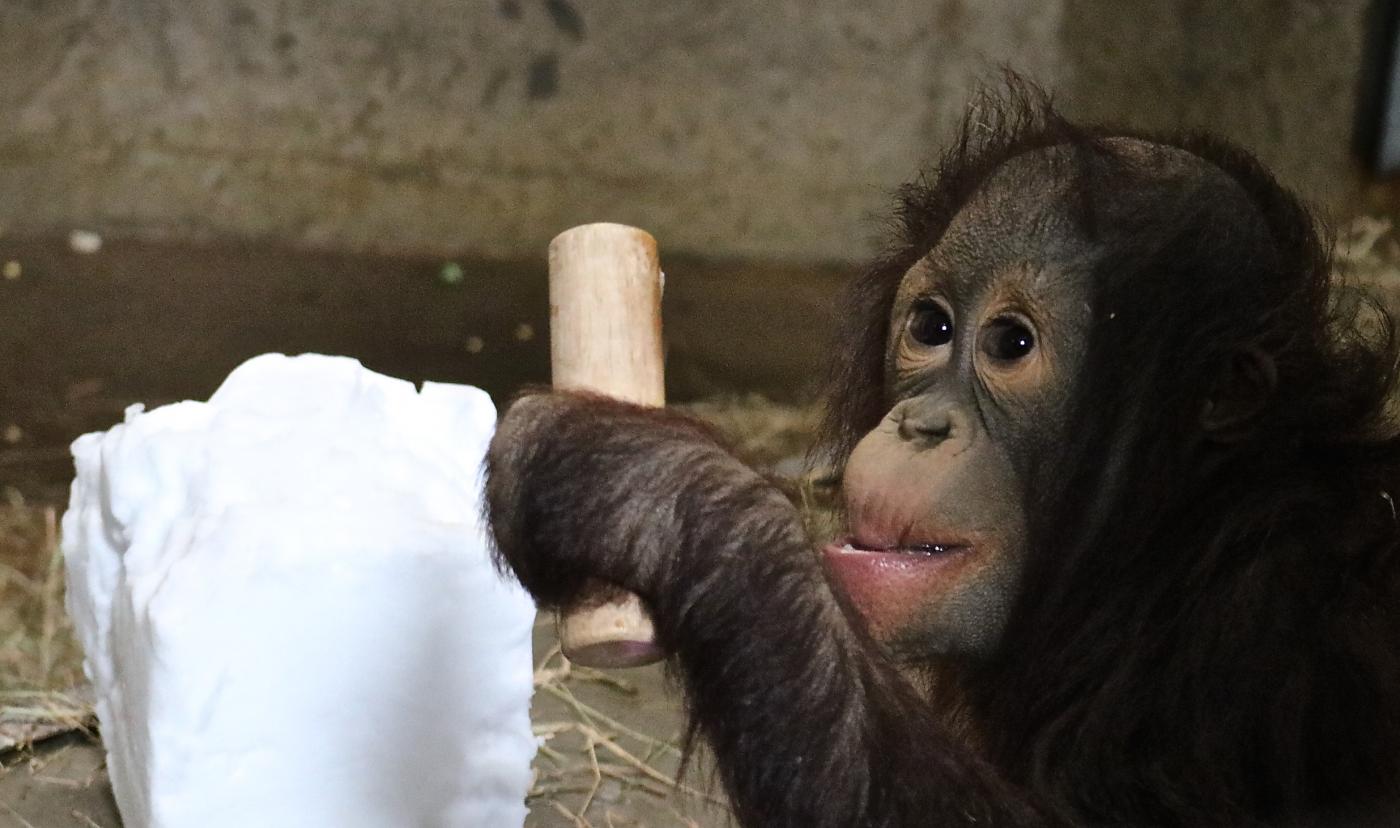
Our orangutans enjoyed eating freshly fallen snow as well. Two-year-old infant Redd came up with the clever idea to use a wooden toy to pick up the frosty snow instead of using his hands.
When we watch our infant apes explore the far reaches of their habitats, we find ourselves holding our breath from time to time. Redd is now a pro on the ropes of the O-Line! Moke is not far behind in his climbing prowess. He is able to reach a firehose that is high up and more than a couple of feet from the mesh. For months he has been reaching out for it but couldn’t quite make the connection. Now, he moves himself between the firehose and mesh like a champ.
The government shutdown has had an impact on the gorilla troop, especially. Baraka is a bit more cranky. We have observed him barking more and stealing food from the other members of his troop. He is normally laid-back and acts as peacemaker of the troop, which makes this behavior quite out of character! The gorillas continue to receive their normal food portions and enrichment items. However, because all primate keepers report for duty at the same time rather than the normal staggered arrival, the timing of food and enrichment offerings is condensed to the morning and early afternoon.
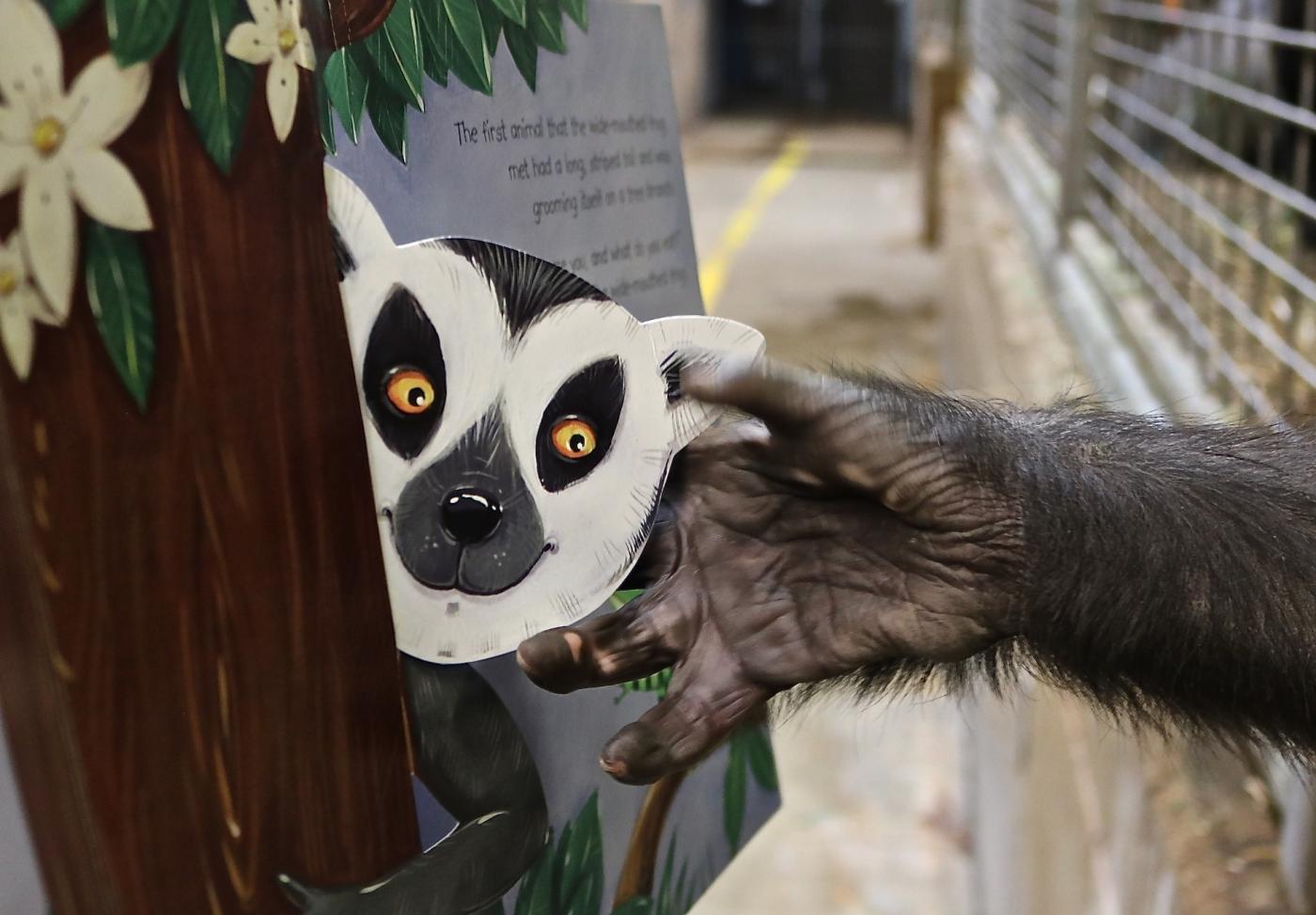
As I mentioned in the Jan. 4 update, our apes have a wide selection of enrichment items. Since the public area of the Great Ape House is like a ghost town, we have been finding new ways to help keep our apes physically and mentally stimulated. Moke and Calaya spent some time looking at a kinetic pop-up book. Surprisingly, Calaya was a little intimidated by the moving figures, but Moke dove right in and enjoyed it immensely! Moke has several toys—including colorful balls, giant LEGOs and blocks—that are his favorite play items and keep his interest for long periods. Late one morning, I heard the toys being banged about and went to observe him at play. To my surprise, Baraka was making noise with the toys. Gorillas are certainly never too old to play! Baraka also made use of one of the sand toys as a water cup. Our enclosures have ‘lickers’ that allow the apes to access water whenever they want it by leaning in and pressing the tab with their lips or fingers. Baraka has used the toy as a convenient cup many times.
Mandara took a few moments to play with a bucket that was filled with balls and blocks. After quick inspections of the treasures, she carried the bucket to the waterfall, collected water in it and drank from her large cup. The bucket lasted a little while before Kibibi had her time with it. She promptly tore it apart. The other toys managed to make it through the shutdown unscathed.
Now that Moke is 9 months old, one noticeable change in his appearance is that his hair is much more fluffy than slick, and the sheen has lessened. Often, visitors ask us if we groom the apes. You may be surprised to know that, for the most part, they maintain their own coats. There are times, however, when we do some nail work if one becomes too long. We use a human toenail clipper for most of the apes. For Baraka’s thick nails, we have used a Dremel to file them down! I was able to capture close-up footage of Baraka picking through his coat. Even though his fingers are large, you can see that he is quite delicate with his grooming habits.
Sometimes when Calaya walks several feet away from Moke, he will toddle after her with cries of distress until she turns around and collects him or lets him straddle her arm or leg. At 15 pounds, Moke has some heft! Moke was in a particularly playful and fearless mood when he tried to catch a ride on Baraka’s leg as his dad walked past him. With glee, Moke wrapped his arms around Baraka’s thigh mid-stride. Baraka promptly lifted his leg higher in the air and shook his pesky son off. Oh, well. Maybe next time, Moke!
Kojo is still enjoying extra attention from the keepers and he continues to interact with the troop at the ‘howdy’ mesh. Kibibi spends the most time with him there, and he and Baraka continue to meet each other at the mesh for rowdy displays.
Last, but certainly not least, Kibibi celebrated her golden birthday on Jan. 10! Our 10-year-old certainly is a delightful little lady. In fact, her name in Swahili means “little lady.” There is significance behind each gorilla name. Baraka is short for his full regal name—Baraka Ya Mwelu—which means “blessing” or “gift from the sun” in the Bantu language. Mandara’s name stems from the Mandara Mountain Range on the Nigeria-Cameroon border. Calaya means “warmth” in the Moru language; Kojo means “born on a Monday” in the Akan language; and Moke’s name means “Junior” or “Little One” in the Lingala language.
Planning to visit Moke at the Smithsonian’s National Zoo? The Great Ape House is open from 9 a.m. to 4 p.m. daily. Don’t miss the gorilla keeper talk at its new time, 1 p.m.! Check the daily demonstrations calendar for this and other fun animal encounters.
Related Species:

